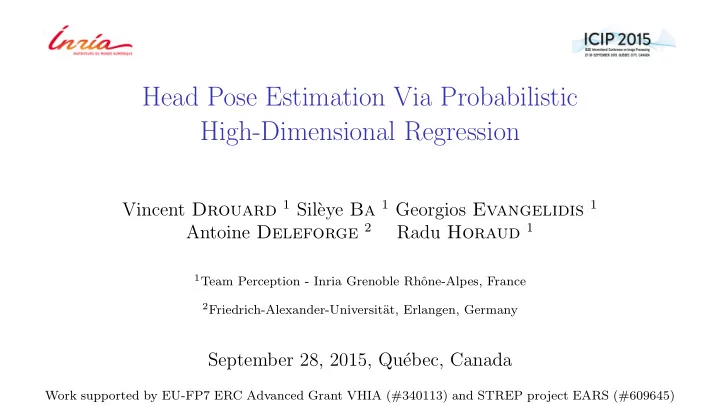

Head Pose Estimation Via Probabilistic High-Dimensional Regression Vincent Drouard 1 Sil` eye Ba 1 Georgios Evangelidis 1 Antoine Deleforge 2 Radu Horaud 1 1 Team Perception - Inria Grenoble Rhˆ one-Alpes, France 2 Friedrich-Alexander-Universit¨ at, Erlangen, Germany September 28, 2015, Qu´ ebec, Canada Work supported by EU-FP7 ERC Advanced Grant VHIA (#340113) and STREP project EARS (#609645)
Introduction Head Pose Estimation Experimentations Conclusion Motivation Visual cue in Human-Robot and Human-Human Interaction 2
Introduction Head Pose Estimation Experimentations Conclusion Problem definition 3
Introduction Head Pose Estimation Experimentations Conclusion Problem formulation 4
Introduction Head Pose Estimation Experimentations Conclusion Method Pipeline 5
Introduction Head Pose Estimation Experimentations Conclusion High-Dimensional Regression Problems: • A lot of parameters to estimate • y → x might be non linear • y and x are obtained by measurement → might be noisy Standard solution • Step 1: dimension reduction, y → x ′ • Step 2: regression, x ′ → x • Head-pose information may be lost when dimensionality reduction is performed 6
Introduction Head Pose Estimation Experimentations Conclusion High-Dimensional Regression - Solution • Inverse problem (training): easier to solve • Forward solution (testing): closed-form 7
Introduction Head Pose Estimation Experimentations Conclusion Training: Inverse Regression (I) K � y = I { Z = k } ( A k x + b k + e k ) k =1 • A k , b k : parameters of the k th affine transformation • e k : zero-mean noise, e k ∼ N (0 , Σ k ) • I : indicator function • Z : discrete latent variable selecting the affine transformation 8
Introduction Head Pose Estimation Experimentations Conclusion Training: Inverse Regression (II) • Probabilistic model P ( y | x , Z = k ) = N ( y ; A k x + b k , Σ k ) P ( x | Z = k ) = N ( x ; c k , Γ k ) P ( Z = k ) = π k 9
Introduction Head Pose Estimation Experimentations Conclusion Training: Inverse Regression (III) • Inverse Regression K π k N ( x ; c k , Γ k ) � P ( y | x ; θ ) = N ( y ; A k x + b k , Σ k ) � K j =1 π j N ( x ; c j , Γ j ) k =1 � �� � ρ k → Proportion • θ = { A k , b k , Σ k , c k , Γ k , π k } K k =1 • Estimated using EM algorithm 10
Introduction Head Pose Estimation Experimentations Conclusion Forward Testing Bayesian inversion of the model K k , Γ ∗ π ∗ k N ( y ; c ∗ k ) � P ( x | y ; θ ∗ ) = N ( A ∗ k y + b ∗ k , Σ ∗ k ) � � � K j , Γ ∗ j =1 π ∗ y ; c ∗ j N j k =1 � �� � k → Proportion ρ ∗ • θ ∗ = { A ∗ k , b ∗ k , Σ ∗ k , Γ ∗ k } K k , c ∗ k , π ∗ k =1 obtained analytically using θ K � x = E ( x | y ; θ ∗ ) = ρ ∗ k ( A ∗ k y + b ∗ • ˆ k ) k =1 � �� � Fast evaluation 11
Introduction Head Pose Estimation Experimentations Conclusion Summary of the model • Closed-form solution for estimating inverse regression parameters • high dimension = 1500 and Low dimension = 3 (or 5) (K=50) • Proposed inverse training: 375K parameters • Standard training: 56M parameters • Forward testing parameters obtained in closed-form from the inverse regression parameters • Estimation (ˆ x ) is efficient (few computations) 12
Introduction Head Pose Estimation Experimentations Conclusion Datasets 13
Introduction Head Pose Estimation Experimentations Conclusion Results with face annotations Biwi-Kinect Head Pose Method yaw pitch roll Fanelli et al. (use 3D information) 3 . 5 ± 5 . 8 3 . 8 ± 6 . 5 5 . 4 ± 6 . 0 Wang et al. (use 2D-3D information) 8 . 8 ± 14 . 3 8 . 5 ± 11 . 1 7 . 4 ± 10 . 8 4 . 9 ± 4 . 1 5 . 9 ± 4 . 8 4 . 7 ± 4 . 6 Our method (use 2D information) Mean Absolute Error (MAE) in degrees for head pose estimation 14
Introduction Head Pose Estimation Experimentations Conclusion Results with face detection Prima Head Pose Method yaw pitch Gourier et al. 10 . 3 15 . 9 Ricci & Odobez 9 . 1 10 . 5 Our method 8 . 7 8 . 85 Mean Absolute Error (MAE) in degrees for head pose estimation 15
Introduction Head Pose Estimation Experimentations Conclusion Examples of head pose estimation 16
Introduction Head Pose Estimation Experimentations Conclusion Examples of head pose estimation 17
Introduction Head Pose Estimation Experimentations Conclusion Examples of head pose estimation 18
Introduction Head Pose Estimation Experimentations Conclusion Conclusion Probabilistic piece-wise linear regression for high dimensional data: • Efficient and accurate solution based on inverse training • Head pose estimation in the presence of face localization errors Next step: • Apply to other problems: articulated motion capture, human-body pose, etc • Extend the model to track head pose 19
Introduction Head Pose Estimation Experimentations Conclusion Thank you for your attention 20
Recommend
More recommend